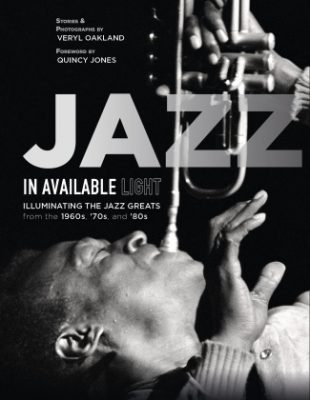.
.
.
…..Jazz in Available Light, Illuminating the Jazz Greats from the 1960s, ’70s, and ’80s is one of the most impressive jazz photo books to be published in a long time. Featuring the brilliant photography of Veryl Oakland — much of which has never been published — it is also loaded with his often remarkable and always entertaining stories of his experience with his subjects.
…..With the gracious consent of Mr. Oakland — an active photojournalist who devoted nearly thirty years in search of the great jazz musicians — Jerry Jazz Musician regularly publishes a series of posts featuring excerpts of the photography and stories/captions found in this important book.
In this edition, Mr. Oakland’s photographs and stories feature the duos of Duke Ellington and Dizzy Gillespie, and Toots Thielemans and Quincy Jones
.
.
.
All photographs copyright Veryl Oakland. All text excerpted from Jazz in Available Light, Illuminating the Jazz Greats from the 1960s, ’70s, and ’80s
.
You can read Mr. Oakland’s introduction to this series by clicking here
.
.
_____
.
.
Perfectly Compatible
.
© Veryl Oakland
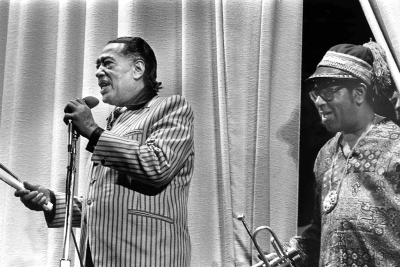
.
Duke Ellington and Dizzy Gillespie
Monterey, California
.
…..Set changes during a jazz festival can be interminable, but they provide a welcome respite for fans needing a bathroom break, refreshments, or a chance to simply walk around and stretch out. But, it’s just not always a good idea to do that.
…..Many fans thought the ideal time to get out of their seats was prior to the opening night’s finale of the 1970 Monterey Jazz Festival featuring the Duke Ellington Orchestra. The Modern Jazz Quartet had just finished, and everyone knew it would take some time to rearrange the stage for a full orchestra.
…..Within a minute or two, I noticed that a grand piano and microphone had been placed outside of the closed curtain to the right of the stage. I went down front. Soon Duke Ellington appeared alone and began a playful banter with the audience. I figured that, as the entr’acte artist, he would simply do some noodling at the piano to help pacify those still in their seats while stagehands completed the necessary changes.
…..But all at once, peeking through a slit in the curtain, stood an impish Dizzy Gillespie with his up-turned trumpet making a surprise entrance. Suddenly, things got serious.
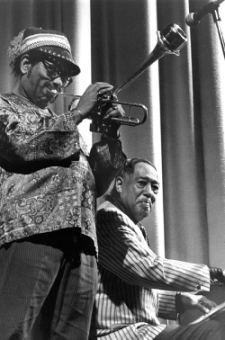
.
© Veryl Oakland
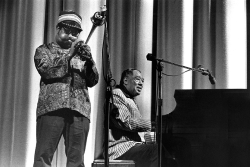
…..Over the next several minutes, the spirited interplay that followed turned out to be one of the highlights of the evening. As the trumpet/piano duo were really cooking, I briefly closed my eyes and envisioned being in the confines of a major jazz club listening to the best of two bop-inspired giants from the past.
…..When they finished, I looked back to see the expressions of those who had remained in their seats, obviously excited with what they had just heard. Two of jazz’s finest had delivered a most unexpected musical treat, and everyone I witnessed couldn’t have been happier. On that special night, I’m sure all of us who hung around believed that Diz and Duke should have been given a complete 45-minute set.
…..It was some time later, after reading his autobiography, Music Is My Mistress, that completely confirmed to me the total genius of Duke Ellington. Had he not devoted his life to composing for, and leading, his nonpareil orchestras, he could have easily made his mark just stretching out, and showcasing his more personally expressive side as a pianist. He would have been the master in any musical style, including bebop.
…..Ellington wrote, “I always liked the bop, and I am proud to say that the fabulous, flamboyant John Birks Gillespie worked in our band once, for four weeks. Diz played with us at the Capitol Theatre (in New York) in 1944 when we had the gorgeous Lena Horne on the bill. Of course, I had known him for quite awhile before that, because I was an avid visitor on Fifty-second Street. I don’t think I missed going there a night after we finished work….”
…..Gillespie recalled the same four weeks he spent with Ellington in his memoirs, To Be, Or Not…To Bop: “Duke had his band set up and used it as an instrument to get certain musical effects, especially tonal colors….What he did for the instruments in the band – the sounds that came out of his band – were unprecedented in the history of jazz, and you will never hear sounds like that again….When the king is dead, long live the king, he’ll be there. You don’t have to worry about him, he’ll be there.”
.
© Veryl Oakland

.
Edward Kennedy (Duke) Ellington – composer, leader, piano
Born: April 29, 1899
Died: May 24, 1974
.
.
© Veryl Oakland
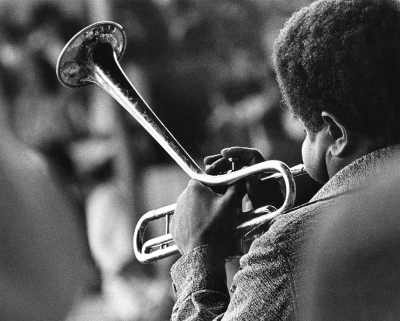
John Birks (Dizzy) Gillespie – trumpet, composer, arranger, singer, leader; also piano
Born: October 21, 1917
Died: January 6, 1993
.
.
Watch Dizzy Gillespie talk about Duke Ellington
.
.
___
.
.
In Search of That Gripping Sound
.
© Veryl Oakland
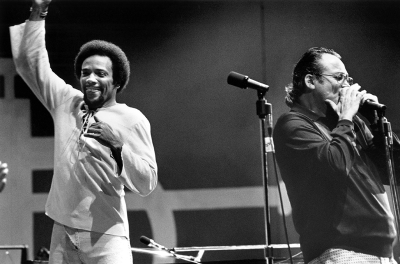
.
Toots Thielemans and Quincy Jones
Monterey, California
.
…..Most everyone growing up has owned or tinkered with the simple and primitive little musical device that fits in the palm of one’s hand. Critic Leonard Feather had it exactly right when he described the harmonica as an “…odd instrument…(with) tonal limitations.”
…..Except in the hands of Jean “Toots” Thielemans. The Baron is the only jazz artist ever to come to prominence as a harmonica soloist, something that will likely never be repeated.
…..Many jazz purists recognized Thielemans’ special gift in the 1950s after he first joined clarinetist Benny Goodman’s sextet as a guitarist, and later teamed with pianist George Shearing.
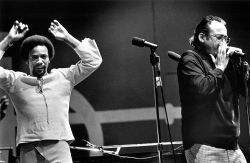
.
© Veryl Oakland
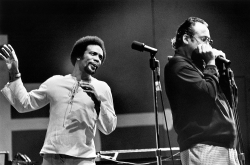
…..But it was after working as a harmonica soloist on numerous albums and motion picture projects in New York with the celebrated producer-arranger Quincy Jones that his star really began to shine. The creative bond that quickly developed between them would not be broken.
…..By the time the general public heard Toots Thielemans’ achingly mournful solo on the unforgettable score for the movie, Midnight Cowboy, the Belgian native essentially had become a household name.
…..Whenever Quincy got the opportunity to leave the studios and take his show live, he would bring together a top-flight crew of favorite musicians he wanted to complement his scores. And for his headliners, he would add such stars as vocalist Roberta Flack, and – more often than not – Toots Thielemans. The results were overwhelmingly popular.
…..Despite working with something so minimal, there was nothing primitive about the sounds that Thielemans coaxed out of his harmonicas. His creativity and expressive flow of ideas matched that of jazz’s top horn soloists – whether he was blazing through a bop-inspired jazz standard, or tearing at every fiber of your being on a tune so poignant and touching that it was guaranteed to bring tears to your eyes.
…..“I can say without hesitation,” said Jones, “that Toots is one of the greatest musicians of our time…. He goes for the heart and makes you cry.”
.
© Veryl Oakland
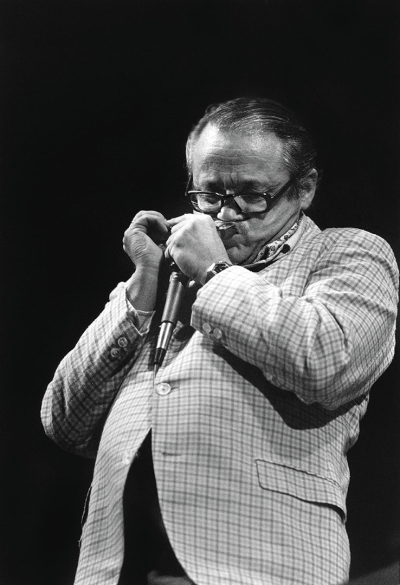
Jean-Baptiste Frederic Isidor, Baron (Toots) Thielemans – harmonica, guitar, composer, whistler
Born: April 29, 1922
Died: August 22, 2016
.
Note: The title, “Baron,” was given by King Albert II of Belgium, who raised Thielemans to the rank of nobility in 2001.
.
.
Listen to Toots Thielemans play harmonica on “I Never Told You,” from Quincy Jones’ 1969 album Walking in Space [A&M/Universal]
.
.
_____
.
.
Click here to read the edition featuring Stan Getz, Sun Ra and Carla Bley
Click here to read the edition featuring Art Pepper, Pat Martino and Joe Williams
Click here to read the edition featuring Yusef Lateef and Chet Baker
Click here to read the edition featuring Mal Waldron, Jackie McLean and Joe Henderson
Click here to read the edition featuring Dexter Gordon, Art Farmer and Johnny Griffin
Click here to read the edition featuring Thelonious Monk, Paul Bley and Cecil Taylor
Click here to read the edition featuring drummers Jo Jones, Art Blakey and Elvin Jones
Click here to read the edition featuring Monk Montgomery and the jazz musicians of Las Vegas
Click here to read the edition featuring Sarah Vaughan and Better Carter
.
.
.
All photographs copyright Veryl Oakland. All text and photographs excerpted with author’s permission from Jazz in Available Light, Illuminating the Jazz Greats from the 1960s, ’70s, and ’80s
.
You can read Mr. Oakland’s introduction to this series by clicking here
Visit his web page and Instagram
.
.
.




